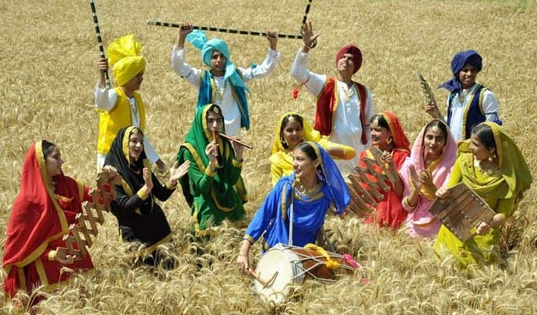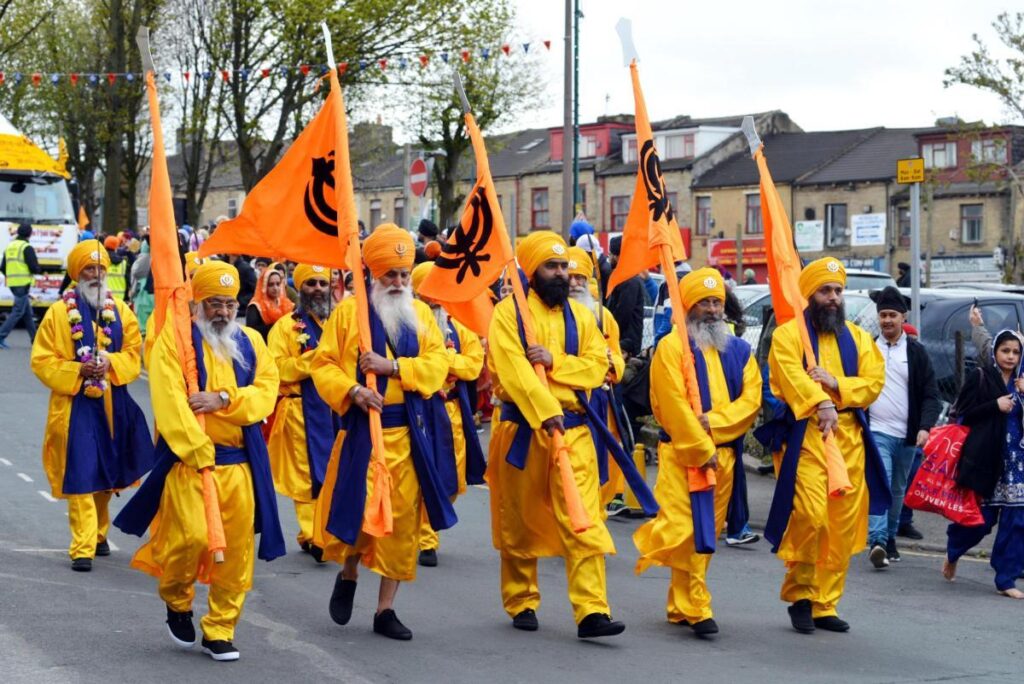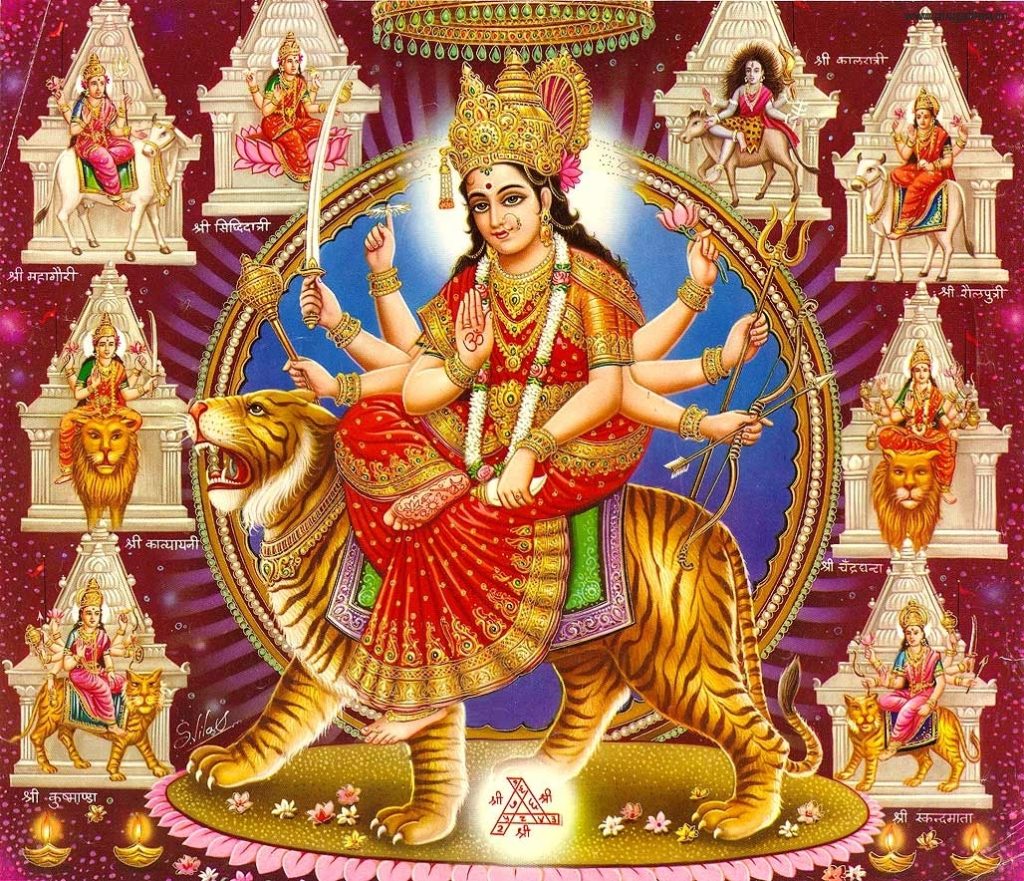Vaisakhi is a significant festival celebrated by people of the Sikh faith. It is celebrated annually on the 13th or 14th of April, marking the beginning of the Sikh New Year and the founding of the Khalsa Panth.
Vaisakhi is also known as Baisakhi or Vaisakh, which comes from the name of the second month in the Hindu calendar. It falls on the first day of the month of Vaisakh.

The History and Origins of Vaisakhi: A Brief Overview
Vaisakhi is a public holiday in India, particularly in the state of Punjab, where people widely celebrate it. Sikh communities around the world, including Canada, the United States, and the United Kingdom, also celebrate it.
.Vaisakhi has a long and rich history that dates back to ancient times in India. People believe that it originated as a harvest festival in the Punjab region, which is located in the north-western part of the Indian subcontinent.
In Hindu mythology
Vaisakhi is associated with the deity Vishnu, who is said to have incarnated as Matsya (the fish) on this day to save the world from a great flood. According to another legend, Vaisakhi marks the day when the Hindu goddess Ganga descended to earth from heaven.
For Sikhs
Vaisakhi holds special significance as it commemorates the formation of the Khalsa Panth, a community of baptized Sikhs, by the tenth Sikh guru, Guru Gobind Singh Ji. On this day in 1699, he summoned his followers to Anandpur Sahib and asked them to volunteer their lives to the cause of Sikhism. He then baptized five Sikhs, known as the Panj Pyare, and initiated the Khalsa Panth to defend the innocent and fight against oppression and injustice.
The Khalsa Panth is also responsible for instituting the five Ks of Sikhism, which include kesh (uncut hair), kanga (comb), kara (steel bracelet), kirpan (sword), and kachera (shorts). These symbols are meant to signify the Sikh commitment to the principles of righteousness and courage, and to remind them of their duty to uphold justice and equality.
Today, Vaisakhi is celebrated by Sikhs and Hindus all over the world with great enthusiasm and fervour. It is a time to celebrate the bounty of nature, to offer thanks to the divine, and to strengthen the bonds of community and brotherhood. The festivities typically involve music, dancing, parades, and feasting, as well as acts of charity and service to those in need.
The Significance of Vaisakhi: Celebrating the Sikh New Year
Vaisakhi is a significant festival for Sikhs, as it marks the birth of the Khalsa and the beginning of the Sikh New Year. It is a time of renewal, reflection, and recommitment to the principles of the faith.
For Sikhs, Vaisakhi is a time to celebrate the founding of the Khalsa Panth by Guru Gobind Singh Ji in 1699. On this day, he gathered his followers at Anandpur Sahib and publicly initiated them into the Khalsa, a community of Sikhs who would commit to upholding the principles of the faith and defending the rights of all people.
The initiation ceremony, known as Amrit Sanchar, involves a series of rituals that are meant to symbolize the shedding of the old self and the rebirth of the individual as a Khalsa. Participants drink Amrit, a mixture of water and sugar crystals that has been stirred with a double-edged sword (Kirpan) and recite the five Sikh prayers (Nitnem).
Vaisakhi is also a time for Sikhs to reflect on their faith and recommit themselves to the principles of the Khalsa. These principles include a commitment to the worship of one God, the pursuit of justice and equality for all, and the practice of selfless service (Seva) to others.
The festival is celebrated with great enthusiasm and devotion by Sikhs around the world. In India, Sikhs participate in processions (Nagar Kirtan) that are accompanied by the singing of devotional hymns (Kirtan) and the playing of traditional musical instruments (Dhol and Nagara).
Vaisakhi is also a important festival among Dogra Hindus
While people of the Sikh religion primarily celebrate Vaisakhi as a festival, some Hindu communities in India, including the Dogra Hindus of the Jammu region, also celebrate it.
For the Dogra Hindus, Vaisakhi marks the beginning of the new agricultural year and is also celebrated as the birthday of Lord Parshuram, who is considered an incarnation of Lord Vishnu in Hindu mythology. On this day, people usually wake up early and take a dip in the holy rivers and perform prayers and rituals to seek blessings for a prosperous year ahead. They also decorate their houses and shops with flowers and light candles to celebrate the occasion.
People in Jammu celebrate Vaisakhi with great enthusiasm and mark it with various cultural events such as folk dances, music, and fairs. They prepare special food items and sweets such as phirni, kheer, and ladoo, and share them with family and friends during the celebration.
Vaisakhi among Dogra Hindus in Jammu may share similarities with Sikh celebration. However, it differs in some aspects and is rooted in local Hindu cultural and religious practices.
Traditions and Customs of Vaisakhi Celebrations
The Sikh community marks the celebration of Vaisakhi with great enthusiasm and joy as it is a significant event for them. The Festival typically involves a range of activities and rituals
Cleaning and Decorating
In the days leading up to Vaisakhi, people clean and decorate their homes and shops with flowers, lights, and rangolis. They also prepare special food items and sweets to share with family and friends.
Traditional Dress
On this day, people wear traditional Punjabi clothes such as salwar kameez or kurta pajama. They accessorize with colourful dupattas (scarves), bangles, and other jewellery.
Gurdwara Visit
People visit the Gurdwara to offer prayers, listen to hymns, and participate in kirtans. People offer prayers to thank and seek God’s blessings for the previous and coming year.
Nagar Kirtan
During the celebration, devotees hold a colourful and vibrant procession. They sing hymns, dance, and play traditional instruments. They carry the Sikh holy book, the Guru Granth Sahib, on a beautifully decorated float or palanquin. The procession, accompanied by drums and food distribution, moves through the streets during the Vaisakhi festival.
Langar
The community prepares and serves a meal or langar to everyone, regardless of their caste, creed, or religion. This meal symbolizes the equality and inclusiveness of Sikhism, where everyone is welcome to share food and celebrate together.
Bhangra and Giddha
Men and women perform traditional folk dances, such as Bhangra and Giddha, respectively.. These dances are accompanied by the dhol, a traditional drum, and celebrate the joy and spirit of the festival.
Dressing up
People wear traditional Punjabi attire with men in turban, kurta, and pajama, and women in salwar kameez or lehenga choli. Bright colours and embroidery are a common feature of these traditional outfits.
Community service
Many Sikhs also engage in community service or seva, which involves volunteering their time and resources to help those in need. They serve food to the homeless, clean up the streets, or donate blood.
On the Occasion of Vaisakhi people seeking blessings from elders, particularly from grandparents and parents, and offering them gifts as a token of respect and gratitude. Customs and traditions vary by region and community, but all reflect the joy, camaraderie, and devotion of Vaisakhi.
Vaisakhi is sacred festival
For Sikhs
Baisakhi is significant as it marks the creation of Khalsa Panth, a community of baptized Sikhs, by Guru Gobind Singh.. He baptized five Sikhs called Panj Pyare, initiating Khalsa Panth to fight against injustice and defend the innocent.

For Hindus
People celebrate Baisakhi as the harvest festival and the start of the new year in many parts of India. Vaisakhi is also a time to express gratitude to God for a bountiful harvest and seek blessings for future crops. People visit temples, perform puja, and offer prayers for a prosperous and happy year ahead.
Overall, Baisakhi is a sacred festival that holds great religious and cultural significance for many communities in India. It is a time to celebrate the bounty of nature, to offer gratitude to the divine, and to strengthen the bonds of community and brotherhood.
Vaisakhi Food: Delicious Dishes to Try During the Festival
Vaisakhi is a time of celebration and feasting, and there are many delicious dishes that are traditionally prepared during the festival. Here are some popular Vaisakhi foods
Langar
Sikh Gurudwaras serve Langar, a vegetarian meal, and also offer it to the public during their religious services. It typically consists of dal (lentils), roti (Indian flatbread), sabzi (vegetables), and kheer (rice pudding).
Chole Bhature
Chole Bhature is a popular Punjabi dish that consists of spicy chickpeas served with deep-fried bread (bhatura). People often serve it with pickles, onions, and yogurt.
Lassi
People make Lassi by mixing yogurt, water, and sugar to make a refreshing drink. They can serve it plain or add flavours such as mango, rose, or other fruits and herbs.
Paneer Tikka
People make Paneer Tikka, a vegetarian dish, by skewering and grilling marinated cottage cheese in a tandoor (clay oven). They often serve it with mint chutney.
Samosas
People make samosas by filling triangular-shaped pastries with spiced potatoes, peas, and onions, and then deep-frying them until crispy. They often serve them with tamarind chutney.
Pakoras
People make pakoras by deep-frying fritters made with chickpea flour and a variety of vegetables. For example – onions, potatoes, and cauliflower. They often serve them with mint chutney.
Kheer
Kheer is a rice pudding that is made with milk, rice, sugar, and cardamom. It is often garnished with chopped nuts and raisins.
Jalebi
People make Jalebi by deep-frying a sweet mixture of flour, sugar, and water, and then soaking it in syrup. They often serve it warm and garnish it with chopped nuts.
People enjoy many delicious dishes during the Vaisakhi festival, and these are just a few examples. Whether you are a vegetarian or a meat lover, there is something for everyone to enjoy during this festive occasion.
Vaisakhi: A Joyous Festival of Harvest and Renewal
Vaisakhi is a joyous festival that celebrates the harvest season and the renewal of the earth. During Vaisakhi, people express gratitude for the harvest and celebrate the beginning of a new growth season.
People in the Punjab region of India celebrate Vaisakhi as a springtime harvest festival. Farmers offer prayers and thanks to God for the bountiful harvest and seek blessings for the new crop season. People dress up their finest clothes, decorate their homes with flowers and rangolis, and enjoy festive music and dance.
For Sikhs, Vaisakhi holds special significance as it marks the creation of the Khalsa Panth by Guru Gobind Singh. On this day, he baptized five Sikhs as the first members of the Khalsa and established a code of conduct for the community. Today, Sikhs around the world commemorate this day by attending religious ceremonies, reading the Sikh scriptures, and participating in processions.
Sikhs participate in seva during Vaisakhi, offering their time and resources to help others in need. This reflects the Sikh belief in selfless service and helping those less fortunate.. This reflects the Sikh belief in the importance of selfless service and helping others.
Overall, Vaisakhi is a time of great significance for Sikhs. Vaisakhi is a significant celebration for Sikhs, marking the birth of the Khalsa and the beginning of the Sikh New Year. It also has cultural and agricultural significance in the Punjab region where it originated.

